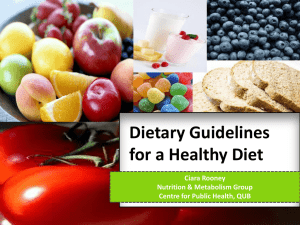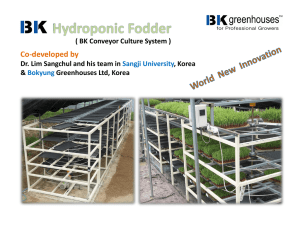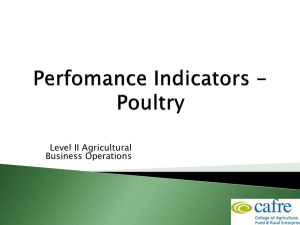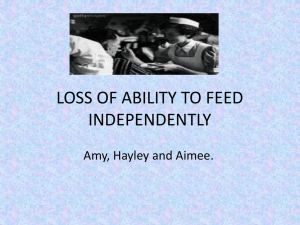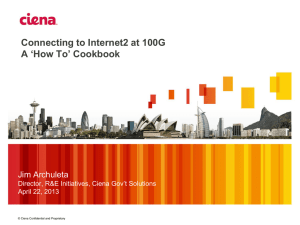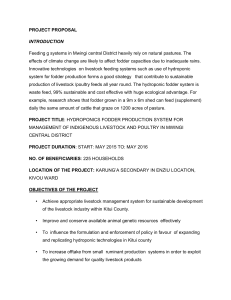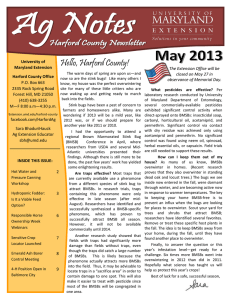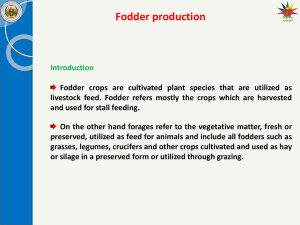Presentation 2
advertisement
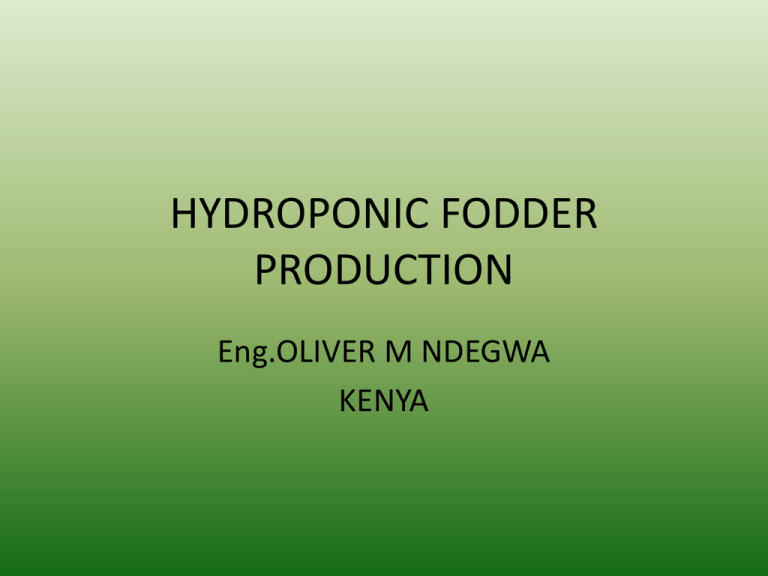
HYDROPONIC FODDER PRODUCTION Eng.OLIVER M NDEGWA KENYA Hydroponic Fodder Benefits to all animals include: • Faster weaning and less stress on mothers and youngstock • Less manure due to increased digestibility of fodder • Boosted immune system • Increased longevity and lifespan • Earlier heat cycles • Improved fertility • Stimulated appetite during heat stress • Better behavior and temperament How it is Done • Day 1: – Seed soaked in water for 2 hrs – Seed poured directly into hydroponic propagation trays at a depth of ½”. – Begin irrigating with water for every 2 hours for 5 minutes ( if in a machine): – Seed Swells How it is Done C’td • Day 2: – Continued irrigation and lighting – White Nodes appear • Day 3: – Continued irrigation and lighting – Seed sprouts: – Chicken start feeding on fodder this day How it is Done C’td • Day 4 : – Continued irrigation and lighting – Leaf starts to take form • Day 5: • - Continued irrigation and lighting Leaf closed >40mm height Day 6 Leaf opens >120mm height Ready to feed RATION CALCUTION AND COSTING • • • • • A tray of 6kgs will feed 2 goats 54 chicken 8-10 rabbits. A Friesian cow needs 16- 20 kg of fodder and 3-5kg of hay. 100 g mineral supplement PIGs • • • • Rearing = ¼ biscuit per day Feeding = ½ biscuit per day Sow out of season = ½ biscuit per day Sow in season = 1 biscuit per day Age of Pig (weeks) Day Weight (in kg) Daily Gain (g/day) Feed consumption (in g) Pigs per biscuit per day 4 28 7 215 490 16 6 42 12.5 395 870 9 8 56 21.3 630 1450 6 10 70 30.5 660 2100 4 12 84 40.5 715 2800 3 14 98 51.5 800 3570 3 16 112 65 965 4550 2 18 126 80 1000 5600 1.5 20 140 95 1100 6650 1.2 22 154 110 1100 7700 1.1 ADVANTAGES, General • • • • • • • Requires little land Fodder produced in 6 days Reduced cost of feed Improved livestock performance Easy to setup system Low cost structure. Little waste water, no nutrients lost in environment ADVANTAGES CT’D • • • • • • • Highly palatable and nutritious Reduces feed costs Improves general fertility, conception rates Increases digestibility of nutrients Improves general animal health Increases new born survival rages Has alkalizing effect on the body (Shipard, 2005). Advantages General • No need for long-term feed storage and no nutrient losses that can be associated with feed storage. • More beneficial to non –ruminants • Organic • Best option for the future where many people increase yet land does not increase. Advantages Beef Cattle • The carcass quality is greatly improved. • Average dairy weight gain 1.7 kg. • To attain weight grain of 1.7 kg in grain fed cattle, large amounts of grains is required which can cause metabolic and digestive problems also most of grains is not utilized and pass through the animal undigested. Advantages Dairy • The milk yield is improved up to 18 - 25% increase. • The butter fat content is raised. • Quality of milk improved • Cows becomes healthy • The time of birth to weaning improved. • Increase in appetite. Advantages goats and Sheep • The carcass quality is greatly improved. • There is improved weight gain at finish feeding. • Sheep gain daily average of 0.083 kg vs 0.053kg when fed a feed lot ratio over six months (fayed, 2011) Advantages Chicken • Pigs and chickens are mostly raised with high stocking density, and also show vast improvements in health and digestion. • The enzymes in barley green feed reduce the passing of “Sticky dropping” in chickens. Therefore the eggs that are laid are cleaner with a yellow yolk due to caroteen. • An increase of up to 40% in egg protein is evident. • Hydroponic fodder helps to eliminate cannibalism among chicken, because there are no deficiencies in their diet. Advantages Pigs • Swine production is enhanced by the rich enzyme content of the barley/oats green feed and is particularly beneficial to weaner aiding in a stressful transition from sows milk to solid food. CHALLENGES • Mold. Moldy sprouts can decrease animal performance and result in animal deaths. Pretreatment of seed with a sterilizing agent (e.g. hydrogen peroxide) is one strategy for preventing mold. • Good hygiene in the system is also important. It is recommended that the growing trays be cleaned between crops with a chlorine based cleaning solution (11). MOLD Repercurtion • • • • • Aflatoxicosis 1 ton of grain comes with 100 billion mold spores Sprouts and mold grow in a warm, wet environment Many molds are toxic to livestock and humans Mold control has limited the use of sprouts as a livestock feed • Chlorine, iodine, and other mold-controlling chemicals can cause damage to enzyems in the sprouts, animals consuming the sprouts, and humans who consume animal's milk and meat Barley Analysis Performed Unit Result Protein Ether Extract Moisture Ash Crude Fibre Acid Detergent Fibre Nitrogen Free Extract Metabolisable Energy Vitamin B1 Vitamin B1 Vitamin B1 Vitamin B1 Calcium Copper Iron Potassium Magnesium Manganese Sodium Phosphorous Zinc % % % % % % % MJ/Kg mg/100g mg/100g mg/100g mg/100g mg/100g mg/100g mg/100g mg/100g mg/100g mg/100g mg/100g mg/100g mg/100g 35.50 3.40 84.00 3.60 15.20 19.00 61.30 11.40 0.20 0.10 4.00 0.20 150 1.30 7.20 180.00 150.00 2.30 36.00 150.00 4.60 3 TON FODDER ROOM. 3 TON FODDER ROOM FOR 180 DAIRY COWS. MILK PRODUCTION 3600 LITERS PER DAY. REVENUE US$ 1800.00 PER DAY. COST OF RATION US$ 983.00 PER DAY MARGIN OVER FEED US$ 817.00 EARNINGS PER FARMER PER DAY US$ 68.08 PER MONTH US$ 2 043.00 High Tunnel Model II (8by30) 1.Engineering Specs Hot Galvanized GI pipe with 200 microns UV Organic(manure) based agronomy Portable unit and easy installation Plant population1000 and output usd120/day for 6 months renewable for 1 extra season Standard Production based on usd 0.50 per plant per day Total Price including agronomy per season is USD2700. Cooperative Model; Ideal for a Group of not more 8 people THANKYOU
